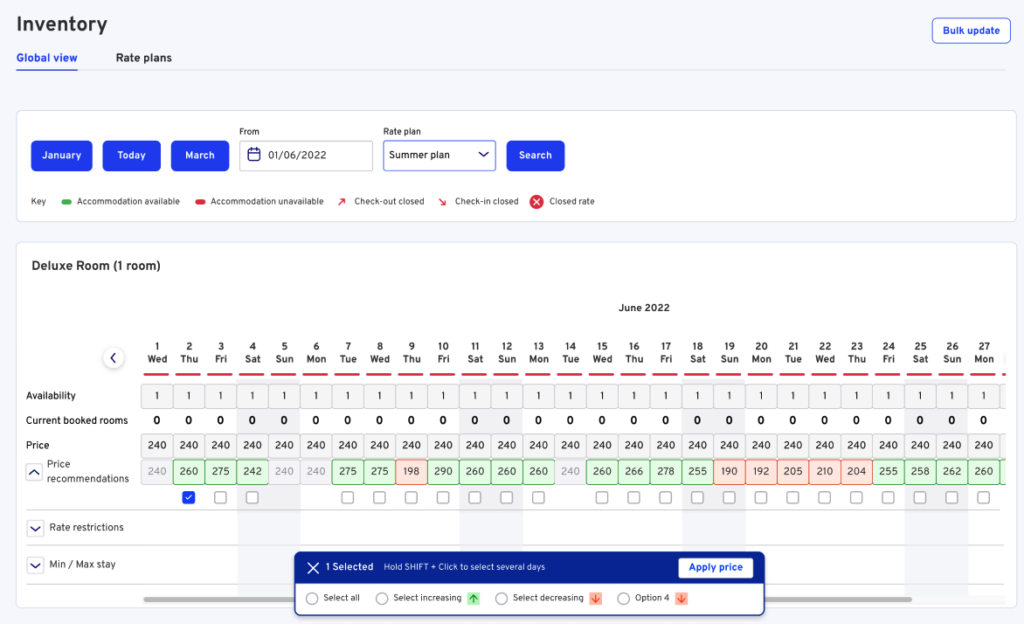The Different Types of Accommodation & How to Take Advantage of Them

For hoteliers or hospitality industry professionals, it's essential to have a thorough understanding of the different types of accommodation available. Thus armed, you can cater to the diverse needs of your guests and provide them with an unforgettable experience.
Offering various accommodation options not only adds value to your business - it helps you stand out in the competitive tourism industry.
Providing multiple types of accommodation ensures that guests can choose an option that best fits their preferences and budget. Some guests may prefer a standard room for a short stay, while others may prefer a suite with more amenities and space for a longer holiday.
In this article, I will explain in great depth how important it is to have different types of hotel rooms and to know how to sell each of them.
By providing various options, you increase your chances of attracting a broader range of guests, thereby increasing your occupancy rates and revenue.
In this article, we will see:
- The most common types of accommodation.
- How to take advantage of them with a proper pricing strategy and with the help of Amenitiz PriceAdvisor.
- Some promotional tactics to increase your bookings.
What Is an Example of Accommodation in Tourism?
As we said, by offering a range of accommodation options, you can cater to the diverse needs and preferences of your guests, providing them with an exceptional experience that they will remember and recommend to others.
Each accommodation type has its own unique features and amenities that cater to different types of guests and situations.
For example, a hotel with conference rooms and business facilities might be best suited for corporate travellers, while a lodge near a national park might be a popular choice for outdoor enthusiasts. A bed & breakfast might be ideal for couples looking for a romantic getaway, while a family might prefer a flat or flat with more space and a kitchen to cook meals.
It's important to understand the strengths, advantages, and limitations of each accommodation type and to offer a range of options to guests in order to provide the best possible experience and meet their individual needs.
A thing that you can do better if you know exactly what is a market target and, moreover, what is yours. However, it's also significant to keep in mind additional costs and great location when making decisions about what types of accommodations to offer.
There are five common types of accommodations: hotels, motels, flats, bed & breakfasts, boutiques, and lodges.
What Are the Four Major Types of Accommodation?
1 - Hotels
Hotels are typically larger establishments that offer a range of amenities and facilities, such as restaurants, bars, conference rooms, and fitness centres. They often have multiple room options, including single rooms, double rooms, suites, and family rooms. Hotels also tend to have high standards of service and cleanliness.
2 - Motel
Motel accommodations are similar to hotels, but they usually have fewer amenities and are geared more towards travellers on the road who require a quick and convenient place to stay for the night. Sometimes, Motels are located near highways or major roadways.
3 - Flats/Apartments
Flats, also known as apartments or holiday/vacation rentals, are self-contained units with separate living areas, kitchens, and bedrooms. They offer guests more space and privacy and are a popular choice for families or groups travelling together.
4 - Bed & breakfasts
B&Bs are smaller establishments that offer a more personalised and homey experience. They typically offer a few guest rooms, frequently with a shared bathroom, and provide guests with a breakfast meal included in the price of their stay. Bed & Breakfast are typically located in residential areas or historic buildings.
5 - Boutique hotels and Lodges
Boutique hotels are unique, often smaller establishments that offer a more luxurious and personalised experience. They tend to have a strong focus on design and decor and often offer amenities such as spas, fine dining restaurants, and unique room features.
Lodges are accommodations typically located in more rural or wilderness areas, typically near national parks or ski resorts. They offer a range of room options and often feature outdoor activities such as hiking or skiing.
Applying Pricing Strategies based on Accommodation Types
As you may know, correctly pricing accommodation is crucial for any hotel or hospitality business to maximize revenue and ensure profitability. Setting prices too high can deter potential customers, while prices that are too low can result in a loss of profit. Hoteliers must find the right balance between price and quality to attract and retain customers.
When setting prices for accommodation, it is important to consider seasonality, target audience, objectives for your business, and other factors. For example, during peak travel seasons or holidays, demand for accommodation is high, and hotels can charge premium prices.
During off-seasons or slower periods, hotels may offer discounts or promotions to attract guests. So you must also consider their target audience, such as business travellers or leisure travellers, and tailor your pricing strategy accordingly.
The only way to determine the best pricing strategy is by analysing data and trends to identify patterns and inform your decisions based on those. You can also consider facilities and factors such as the cost of additional amenities or services, such as room service or parking, and adjust prices accordingly. A long and time-consuming activity, right?
Moreover, hotels can use dynamic pricing to adjust room rates based on demand and availability in real-time. This allows hotels to maximise revenue by adjusting prices based on supply and demand, and ensures that rooms are priced competitively in the market.
Amenitiz PriceAdvisor
This is the answer when it comes to having the best dynamic pricing strategy at the best price for you.
Amenitiz PriceAdvisor is an Amenitiz product that all Amenitiz's clients can activate on their account with a Free version and eventually upgrade to a Premium one. A great advantage to have over your competitors. Amenitiz PriceAdvisor is something that someone in the tourism industry should have.
It is a complex algorithm that helps you to give the right price at the right time, basing its calculations on:
- Past demands
- Your competitors
- Your Occupation rate
- Seasonality
It's a suggestion that you will see in your calendar, as is shown in the image below:

This means that you will not have any more to:
- Spend hours calculating and revising numbers and occupation rates in a certain period of the year.
- No more spying on your competitors, wasting whole days.
- No more empty rooms or flats, your occupancy rates will skyrocket.
- Lose information connecting data, as Amenitiz PriceAdvisor is connected with the Property Manangement Software, that centralise all Amenitiz's Products.
Promotional Tactics to Increase Bookings on All Accommodation Types
When it comes to marketing different types of accommodation good promotional tactics are incredibly effective. Promotional tactics are essentially any activities that are designed to promote your accommodations and attract more guests. This can include things like advertising, social media campaigns, email marketing, special offers, and more.
There are a lot of Marketing strategies that you can implement for your business. Here are some examples of promotional tactics that are effective for different types of accommodation:
- Social media campaigns that showcase the amenities and facilities of the hotel, special packages for families or couples, and loyalty programs for repeat guests.
- Email marketing to past guests, offering seasonal discounts, and promoting local events and attractions.
- Have an effective website connected to Google Hotel, where you periodically do promotions and discounts.
- Listing on holiday rental OTAs like Airbnb, creating engaging property listings with high-quality photos and descriptions, and offering discounts for extended stays.
To measure the effectiveness of these promotional tactics, it's important to track metrics such as website traffic, social media engagement, and bookings. You can also ask guests how they found out about your accommodations and adjust your tactics accordingly.
For example, if you notice that social media campaigns are generating a lot of interest, you may want to allocate more resources towards that tactic in the future.
So, promotional tactics can be a powerful tool for marketing different types of accommodation. By understanding your target audience and using the right tactics, you can attract more guests and boost your revenue. Just be sure to measure the effectiveness of your efforts and make adjustments as needed.
FAQ: Know More About Types of Accommodation
1 - What is the benefit of having different accommodation types (or room types) in the tourism sector (in a hotel or holiday rentals business) ?
Some people use accommodations to indicate "rooms". So in this section I will explain the benefits and advantages of offering different types of accommodations in the tourism sector.
Firstly, it can attract a wider range of customers with varying needs and budgets. By providing options like single rooms, double rooms, suites, and family rooms, businesses can cater to different group sizes and preferences.
Secondly, having various accommodation types can increase revenue by allowing businesses to charge different rates for different room types. Guests who are willing to pay more for luxurious amenities can opt for suites, while those on a budget can choose simpler accommodations like single or double rooms.
Additionally, offering different accommodation options can help businesses stand out in a competitive market and create a unique brand image.
Finally, providing a range of accommodations can increase customer satisfaction by giving guests the flexibility to decide the type of room that best suits their needs and preferences.
Join 15K+ hoteliers
simplifying their daily
operations with Amenitiz.



